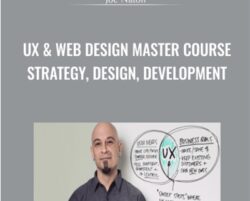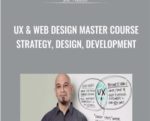WHAT WILL YOU LEARN?A clear understanding of the principles and benefits of good UX and how to apply it to your websiteA strategy for making sure you know what people need from your website, and what you or your client needs from it in order to succeedThe confidence to know what information should be included in your website, and how to design it to increase conversionsThe ability to code a variety of websites with HTML, CSS, WordPress, and other toolsREQUIREMENT Need a willingness to learn!Adobe Photoshop Free Trial versionAxure RP Free Trial versionIn order to install and configure WordPress for the last two sections, you will need a hosting plan, either paid or free (Google “free WordPress hosting” for options)Get UX & Web Design Master Course: Strategy, Design, Development – Joe Natoli, Only Price $39DESCRIPTION This course will teach you everything you need to know about UX, including design, content, and coding. And you’ll learn from the ground up, so it doesn’t matter how much experience you have when you start.You’ll be exposed to principles and strategies, but, more importantly, you’ll learn how to actually apply these abstract concepts by coding three different websites for three very different audiences.Improve Your Website with UX StrategiesApply UX strategies to a site’s content & designUnderstand Information Architecture to enhance the content on your websiteKnow what dictates how your website should lookDesign and code a B2B website, a B2C blog, and an ecommerce siteUnderstand UX and Learn How to Develop Winning WebsitesThis course will help you stand out as a web designer, teaching you how to apply User Experience (UX) strategies that will make every site you build useful, usable, and valuable.Reinforce what you’re learning using the bonus 30-page downloadable UX Guidebook. Filled with exercises and activities, the UX Guidebook is a great tool to reference as you progress through the course, or while developing your own custom sites.You’ll also get hands-on experience designing and coding three different types of sites. This will give you the confidence to pursue similar projects if you’re already a website designer, if you want to get into web design, or if you want to enhance your current business site.Contents and OverviewEven if you’re a complete beginner, this course will show you how to make a website functional, attractive and successful. It will walk you through all of the steps required to enhance the User Experience on any site, right down to the code, content, and design.You’ll begin by defining who your website users are and what they expect from the website. You’ll also learn how business goals — yours or your client’s — have to be uncovered and addressed for site success.You’ll learn what questions to ask both groups, and you’ll use the answers to inform your content and design decisions.Next, you’ll dig into Information Architecture (IA), which looks at the content on your website, how you should categorize it, what you should call it, and more.This will lay the foundation on which you can further build out your website to make users flock to it, stay on it, and hopefully make purchases.Plus, you’ll tackle how to design your website depending upon who your visitors are, whether your website is B2B (business-to-business), B2C (business-to-consumer), or an ecommerce site for selling products online.Different audiences have different needs, so learning what your target user expects from your site means you’ll be able to design and build a site that meets those expectations and leads to greater conversions.In addition to knowing what you need to put into your website to make it stand out from the crowd, you’ll also learn how to identify and remove UX- and UI-related obstacles.The ability to see and solve these problems will ensure every website you build moving forward will be useful, usable and valuable to the people who use it.Most importantly, you’ll then learn how to actually build and code these types of sites using HTML, CSS, WordPress, and more.You’ll not only know how to effectively design B2B, B2C, and ecommerce sites, but you’ll also know exactly how to develop these sites, from start to finish.By the end of this course, you’ll have an in-depth understanding of UX and web design, as well as the tools to develop a variety of sites with the right code.You’ll know why UX is so important to both users and businesses, what content is needed on a site, what UI design is appropriate, and how to transform your vision into a fully functional website using the most effective tools available.WHO IS THIS FOR?New or established business owners who want to gain more from their online presenceBeginners who want to learn UX, web design and/or developmentWebsite designers who want to enhance their skillsPrint designers who want to move into web designGet UX & Web Design Master Course: Strategy, Design, Development – Joe Natoli, Only Price $39CURRICULUM Course OverviewWelcome: Get Ready to Define. Design and Code! Download the BONUS 30-paae Course GuidebookIntroduction to UXDefinition: Planning for SuccessWhy Are We Doing This? Three Crucial Questions (You Must Ask) What’s Worth Doing? What Are We Creating?What Value Does It Provide? SNACK BREAK: Who Are Your Users?Exercise: Determining Value & Strategic OpportunityDefinition: Planning for Success Part II It’s Not Just About Users: The UX Value Loop v Business Stakeholder Research Identifying Business Goals vSNACK BREAK: What Are Your (or Your Client’s) Business Goals? User Research: Putting People First Identifying User Needs vDecision Paths: Connecting User Needs with Strategy vExercise: Create a Decision PathIntroduction to RequirementsGenerating Meaningful Requirements vThree Kinds of Requirements vDocumenting Requirements vDetermining Project Scope vControlling Scope Creep vExercise: Smart Project ScopingDefinition: Planning for Success Part IIIPlanning for User Testing Creating a Test Plan: Who Are We Testing For?Prioritizing Device and Browser Support What to Test: Functionality What to Test: Usability What to Test: Errors and Exceptions What to Test: Compatibility What to Test: Performance What to Test: Security Definition Takeaways: Things to RememberInformation Architecture: Organizing Content and FlowWhat IS Information Architecture (IA)? Content Strategy: Identifying, Organizing and Delivering Determining Content Requirements Exercise: Identifying Content WorkflowsMy Tips for Successful Information IA Modeling Creating and Prioritizing IA Content Labeling File Naming Grouping and Classifying Content Exercise: Determining Information PriorityInformation Architecture: Creating a Solid FoundationInformation Architecture: Creating a Solid Foundation Part IIExercise: Turning Information Priority into an IA ModelIA Models: Which One’s Right for My Site? Hierarchical Tree IA Model Nested List IA Model Hub and Spoke IA Model Bento Box IA Model Filtered View IA Model Combining IA Models Tools for Creating IA Models Socializing and Validating Your IA Model SNACK BREAK: Create an IA Model for Your WebsiteInformation Architecture: Creating a Solid Foundation Part IIINavigation Design Primary and Secondary Navigation Global and Local Navigation Navigation for Different User Types Validating Your Navigation Scheme Exercise: Determining Key Navigation Paths Wireframing 101 What a Wireframe ISN’T What a Wireframe IS My Tips for Creating Successful Wireframe Prototypes Creating Wireframes: Tools of the TradeSNACK BREAK: Try Creating a Basic Wireframe on Your Own Exercise: Creating a B2B Wireframe with Axure RP ProSocializing and Validating Wireframes Information Architecture Takeaways: Things to RememberDesign: Information, Interaction and Interface”What’s It Gonna Look Like?”An Introduction to Design Defining Appropriate User Interface (Ul) DesignHow Definition and IA Inform Ul Design v Timeless Ul Design Principles, Part 01 Timeless Ul Design Principles, Part 02Timeless Ul Design Principles, Part 03Timeless Ul Design Principles, Part 04SNACK BREAK: Identify Design Principles in an Existing UlDesign: Information, Interaction and Interface”What’s It Gonna Look Like?”An Introduction to Design Defining Appropriate User Interface (Ul) DesignHow Definition and IA Inform Ul Design v Timeless Ul Design Principles, Part 01Timeless Ul Design Principles, Part 02 v Timeless Ul Design Principles, Part 03Timeless Ul Design Principles, Part 04SNACK BREAK: Identify Design Principles in an Existing UlDesign: Information, Interaction and Interface Part IIMy Tips for Solving Visual Problems Organizing Visual Information – Part 01 Organizing Visual Information – Part 02 Designing Appropriate Visual Hierarchy Designing for Audience Expectation Designing for Interaction Exercise: Create a Ul Design for a B2B Website Exercise: Create a Ul Design Layout for a WordPress Blog -Part 01Exercise: Create a Ul Design Layout for a WordPress Blog -Part 02Exercise: Create a Ul Design Layout for a WordPress Blog -Part 03Exercise: Create a Ul Design Layout for a WordPress Blog -Part 04Exercise: Create a Ul Design Layout for an Ecommerce WebsiteSNACK BREAK: Evaluate Your Ul Design Design Takeaways: Things to Remember Development – Building a B2B Website with HTML & CSSDevelopment: Coding, Customizing and Configuring Dreaming in Code: You’ve Got the Power! Hosting & Domain Considerations File Structure and FTP: Organizing & Uploading Basic HTML Structure: Building a Solid Foundation Tags, Elements and Attributes: Describing HTML Content What’s In a Name? Titles and Headings Formatting Paragraphs: Creating and Styling Text Content Organizing Your Code: Using Indentation and Comments Creating Your First Web Page: Applying What You’ve LearnedContent Elements – Hyperlinks: Getting from Here to There Content Elements – Unordered and Ordered Lists: Creating v and FormattingContent Elements – Images: Adding Images and Defining v AttributesContent Elements – Audio and Video: Adding Media to v Your Web PageContent Elements – Audio and Video: Adding Media to v Your Web PageFont Styling: Defining Style, Color and Size Exercise: Adding Images, Unordered Lists and Hyperlinks CSS – Content Styling: Adding Good Skin to Good BonesCSS – Inline, Internal or External? Getting SmartCSS – Inheritance: Sharing Attributes EfficientlyCSS – Background Color and Image: Creating Background EffectsCSS – Font Color and Weight: Giving Text Impact and EmphasisCSS – Classes and Spans: Getting Specific with StylingCSS-Working with Dlvs: Dividing and Conquering with Classes and IDsCSS – Link Styling: Using Text DecorationExercise – Creating a Navigation Menu: Leveraging CSS for WayfindingBasic Table Structure: Organizing ContentStyling Tables with CSS: Enhancing Communication and ReadabilityMargins and Padding: Establishing Purposeful Negative Space Display and Positioning: What, Where and HowThe Box Model: The Parts and the WholeFloat and Clear: Controlling Visual FlowNested Layouts: Using Dlvs for Precision and FlexibilityForms: Creating Good Input (and Output)Creating Forms: Grouping Form DataStyling Forms with CSS: Creating Consistency and UsabilityGet UX & Web Design Master Course: Strategy, Design, Development – Joe Natoli, Only Price $39Tag: UX & Web Design Master Course: Strategy, Design, Development – Joe Natoli Review. UX & Web Design Master Course: Strategy, Design, Development – Joe Natoli download. UX & Web Design Master Course: Strategy, Design, Development – Joe Natoli discount. web design masterclass. web design master’s degree. web design masters uk. web design master degree online. web design masters in canada. web design master gulp. web design master github.
UX & Web Design Master Course: Strategy, Design, Development – Joe Natoli
₹5,810.00






